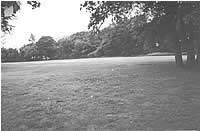Waste Site Cleanup & Reuse in New England
Bunker
Hill Park
Naugatuck Valley
Success in EPA-Lead Targeted Brownfields Assessments
Waterbury, CT
(July 14, 2003)
Contacts
|
The Naugatuck Valley Brownfields Pilot (NVBP) used $15,000 to perform a limited Phase I and Phase II environmental site assessments (ESAs) through the EPA Brownfields Assessment program in April 2001. The funding was utilized to confirm if reported historical ash dumping on a property in Waterbury, CT, actually occurred. The Phase I and Phase II ESAs were completed in April 2001 and found that the site does not present health risks to the nearby community. The cleanup of the subsurface soil contamination has been completed. In the fall of 2003, the city of Waterbury will begin to redevelop the site as green open space for community use.
The Naugatuck Valley Brownfields Pilot (NVBP) is managed by the
Valley Council of Governments and was established with a grant from
EPA New England in November 1996. NVBP’s goal is to provide
assistance to its eleven municipal members (Ansonia, Beacon Falls,
Derby, Naugatuck, Newtown, Oxford, Seymour, Shelton, Thomaston,
Waterbury, and Watertown) in building brownfields management capacity.
There are approximately 100 brownfield properties in the Naugatuck
Valley and NVBP has provided assistance to 30 projects thus far.
(www.lnvalley.org/DERBY/brownfields.htm ![]() )
)
According to the demographic information from the US
2000 Census, ![]() the city of Waterbury is a low-income community with a large percentage
of its total population as minority. The city of Waterbury has a
population of 107,271 people, with 16.31% of the total population
African-American and 21.8% Hispanic or Latino. The state of Connecticut’s
population is 3,405,565, with 9.1% of the total population African-American
and 9.4% Hispanic or Latino. The city of Waterbury’s median
household income is $34,285, compared to $53,935 statewide. The
city of Waterbury’s unemployment rate is 5.3%, compared to
the statewide unemployment rate of 3.5%. The city of Waterbury had
3,428 families in 1999 who live below the poverty line.
the city of Waterbury is a low-income community with a large percentage
of its total population as minority. The city of Waterbury has a
population of 107,271 people, with 16.31% of the total population
African-American and 21.8% Hispanic or Latino. The state of Connecticut’s
population is 3,405,565, with 9.1% of the total population African-American
and 9.4% Hispanic or Latino. The city of Waterbury’s median
household income is $34,285, compared to $53,935 statewide. The
city of Waterbury’s unemployment rate is 5.3%, compared to
the statewide unemployment rate of 3.5%. The city of Waterbury had
3,428 families in 1999 who live below the poverty line.
Bunker Hill Park, also known as Schofield Park, has served as green open space for approximately 50 years under the ownership of the Bunker Hill Congregational Church. The late Mr. Frank Hess, Jr. willed this adjacent property to the church and requested that the church maintain the property as green open space for community use. Mr. Hess was also the part owner of the Waterbury Ash Company, which collected ash from commercial establishments and residential households’ coal and wood-burning furnaces. Questions had arisen as to whether ash material was dumped on the property. The church has leased the property to the city of Waterbury for the last 50 years to maintain the site as green open space.
In 1995, the city of Waterbury decided to improve the park and requested that the Connecticut Department of Protection (DEP) purchase the property from the Bunker Hill Congregational Church and lease it to the city of Waterbury so the city could make improvements to the site. However, the DEP needed to conduct an ESA before they could purchase the propert. The city therefore requested assistance from EPA New England.
The conclusions of the Phase I and Phase II ESAs showed that polycyclic aromatic hydrocarbons (PAHs) were the common contaminants in the subsurface soils. PAHs are a group of chemicals that are formed when coal, oil, garbage, tobacco, food, or any other organic substance are burned. Since the contaminants are still located in the subsurface soil, the Connecticut DEP recommended that erosion of the surface soils should prevented. The Connecticut DEP also recommended that the green open space’s cover of grasses and shrubs should be well maintained and signs should be posted to call the city Health Department before digging at the property. In the fall of 2003, the city of Waterbury will make the improvements to the green open space by utilizing $270,000 in funding it received from the State Bond Commission in 1995 for that purpose. The funding leverage created by the EPA Brownfields Assessment grant allowed valuable green open space to be preserved and enhanced in the city of Waterbury.

